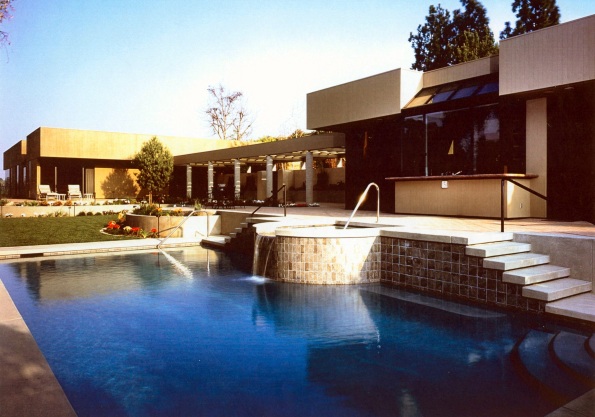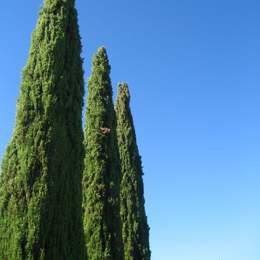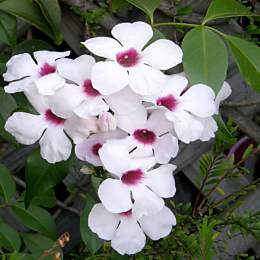|
|
|
|
|
 The biggest news and concern most of us plant lovers have is about the
drought and water restrictions. The good news is we have proven that our lawns
can survive on twice a week water (you may have a few stress spots but it is
possible). Our annual flower beds are going to need more water than that, so
somebody will have to water them with a hose if we are going to obey the law.
The biggest news and concern most of us plant lovers have is about the
drought and water restrictions. The good news is we have proven that our lawns
can survive on twice a week water (you may have a few stress spots but it is
possible). Our annual flower beds are going to need more water than that, so
somebody will have to water them with a hose if we are going to obey the law.
Fall is the best time
for planting. We need less water to get plants established; roots grow most in
the fall and winter. The right tree can actually help save energy and water by
providing shade. If our lawns can survive on twice a week water in the summer
our water wise trees and shrubs can survive on considerably less.
Mark Meahl
(President Garden View Inc.)
|
|
Pasadena Project

This contemporary pool, pool house, hardscapes and extensive
gardens were constructed by Garden View a few years back.
|
 |
| September Gardening Tips
 GERANIUM SANGUINEUM (LEFT):
GERANIUM SANGUINEUM (LEFT):
Cut hard now to increase bloom and have a compact plant for the winter.
 CREPE MYRTLE TREES -Lagerstroemia (RIGHT):
CREPE MYRTLE TREES -Lagerstroemia (RIGHT):
These beautiful low water and long flowering trees need minimum maintenance but it is very important to remove suckers growing from the trunk. If suckers are alloyed to grow the tree may get powdery mildew which looks like it sounds growing on the leaves and the branches. This will be especially profound if the tree is growing in a regular watered lawn.
SYCAMORE TREES, FRUIT TREES
and many other trees will be showing excessive leaf drop during the heat. They are not able to move enough water from the ground to the leaf and/or fruit. To protect itself the tree drops leaves and fruit. This is ok and natural. The fewer fruit will result in better and larger fruit at harvest time. Adding more water may not help. Trees that have been grown with frequent watering thus producing smaller roots will be more likely to have leaf drop. Most large trees appreciate an occasional deep watering. This will increase the debt of the roots system, the storage capacity of the tree and many benefits.
AVACODO TREES:
Don't be alarmed by a lot of leaf drop on mature plants. Avocados leaf litter nearly year round and are affected by the heat as described above. This is a normal condition. Be sure to keep a very thick blanket of mulch, compost or fallen leaves under mature avocadoes at all times. Avocadoes need a cool root-run for good health.
 AGAPANTHUS Lily of the Nile (LEFT)
AGAPANTHUS Lily of the Nile (LEFT)
This is one of southern California's favorite plants. It is a nice attractive strap leaf shrub most of the year with beautiful flowers in late spring and early summer and it is relatively water wise.
 In the full sun and extreme heat the leaves will often show some signs of fading or scorching especially where the leaves are bending. Not much can be done about this and it lasts only a month or two. Many FLAXES -Phormium (RIGHT) will also have the same reaction to extreme heat. It is best to leave the scorched leaves until the heat has passed as they are protecting the leaves underneath. Remove the dead leaves at the bottom of the plant as you would normally.
In the full sun and extreme heat the leaves will often show some signs of fading or scorching especially where the leaves are bending. Not much can be done about this and it lasts only a month or two. Many FLAXES -Phormium (RIGHT) will also have the same reaction to extreme heat. It is best to leave the scorched leaves until the heat has passed as they are protecting the leaves underneath. Remove the dead leaves at the bottom of the plant as you would normally.
 WHAT IS ROLLING UP THE SOD IN MY GARDEN?
WHAT IS ROLLING UP THE SOD IN MY GARDEN?
Raccoons, skunks, and other animals can be a considerable nuisance when they roll up freshly laid sod in search of earthworms and grubs. They may return repeatedly and roll up extensive areas of sod on successive nights. This behavior is particularly common in mid- to late summer as young raccoons are learning to forage for themselves, and during periods of dry weather when other food sources may be less available. Garden View Gardeners have also observed that this problem is much more severe when sod is new and being watered excessively. The grubs come to the surface and the animals find them easy prey, Garden View Landscapers have found that soil drenching insect killers like Merit, Bayer's Advanced Season Lawn Grub control or Bayer's Advanced complete insect killer for lawn and soil helps. Turning down the water also makes a big difference.
LAVANDULA - Lavender (RIGHT):
 These plants prefer well drained soil and very little or no fertilizer. To keep the plants neat and compact shear back 1/3 to ½ of the plant immediately after bloom. If the plant becomes woody remove a few of the oldest branches, remove more when new growth comes. If this does not work remove and replace the plant. This plant does best if compost is not put around it. Gravel works good though.
These plants prefer well drained soil and very little or no fertilizer. To keep the plants neat and compact shear back 1/3 to ½ of the plant immediately after bloom. If the plant becomes woody remove a few of the oldest branches, remove more when new growth comes. If this does not work remove and replace the plant. This plant does best if compost is not put around it. Gravel works good though.
 HIBISCUS (LEFT):
HIBISCUS (LEFT):
Stop pruning now so that they are hardened off for winter frost and better blooms next spring. If you have to, give it one more slight pruning now but stop after that for the winter. Garden View gardeners have observed that over fertilized and overwatered Hibiscus are more susceptible to white fly problems.
 NEW ZEALAND TEA TREES AND SHRUBS -Leptospermum (RIGHT):
NEW ZEALAND TEA TREES AND SHRUBS -Leptospermum (RIGHT):
Don't prune in Fall. This plant has magnificent blooms in Spring trimming in fall will reduce the abundance of blooms. This is an easy to maintain, low water need plant. Best if grown in well draining soil. Watch that they don't get overwatered in clay soil as they may get a root rot.
 LONICERA SEMPERVIRENS -Honeysuckle (left):
LONICERA SEMPERVIRENS -Honeysuckle (left):
blooms from late spring through much of the summer, prune heavy in early spring and again at end of flowering in September.
 POTTED SUCCULENTS (RIGHT):
POTTED SUCCULENTS (RIGHT):
Feed with a well diluted liquid fertilizer.
AMEND SOIL FOR PLANTING:
Spade or rotary-till plenty of organic matter into beds before
doing any planting.
CARE FOR ROSES:
Cool fall days bring out some of the year's best rose blooms. Many
rosarians insist that fall roses have deeper color and spicier
fragrance than spring blooms. To keep blossoms coming, continue
to water and cut off spent flowers regularly, however, don't
fertilize plants until next spring.
Click Here to read the rest of the article!
|
 |
Water-Wise Tips
Protect our resources and your water bill
|
|
TWO DAYS PER WEEK LAWN WATERING IS ENOUGH!
It can be done if you train the roots deep. Water restrictions in Los Angeles have made it illegal to water more than twice per week. You can have a green lawn if you follow the suggestions about deep and spaced out watering that I have been preaching for the last 20 years. The proof is in the pictures. The pictures are of lawns Garden View maintains in the Monterey Hills area and of some our competitors maintained lawns in the same community.
Training the roots deeply can not be done overnight. It takes time to slowly train the root deeply. The best time to start training the roots is in fall and winter.
Benefits of Deep Watering by Mark Meahl:
Simply stated, encouraging deep root growth is universally accepted as
good horticultural technique. When you water everyday the roots have
no need to go deep for water because they have what they need without
the effort of growing downward. When you water daily the subsurface
becomes saturated and no oxygen or bacteria can grow. This can kill
existing roots and cause fungus and disease. The new roots we are
trying to grow deeply into the ground will not grow down into the over
saturated soil. When it gets hot out, the surface is the first
place to dry out. Even though there is water deeper in the
ground the grass or plants dry out because their roots are only on the
surface and not tapping the deeper water. This is when many people get
caught in the Catch-22 situation; "If I don't water the plants or lawn
daily they dry out, if I water daily the roots don't grow down."
Again, shallow roots create this problem. One
of the biggest problems of over-watering is that trees don't develop
deep root systems and the roots of older, more mature and larger trees
may come to the surface looking for air. Click Here to read the rest of the article!
|
|
 |
In the Dirt
with Julie Meahl
 Trees offer so much to us and the
environment. They add value, beauty, comfort, and ambience to our homes
and neighborhoods and replace carbon dioxide with oxygen--giving us clean air.
Trees offer so much to us and the
environment. They add value, beauty, comfort, and ambience to our homes
and neighborhoods and replace carbon dioxide with oxygen--giving us clean air.
Trees can shade your house from the hot summer sun, reducing temperatures
indoors and saving on air conditioning costs. You should provide
afternoon shade on the hot south and west side roof and walls as much as reasonable. Trees
also provide shade for grass and planters which can help save on your water
bill.
Most of our customers come to us
asking for evergreen trees but you should really consider deciduous varieties
also. Deciduous trees drop their leaves in the winter allowing the sun's rays
to shine through thus warming your house in the winter, which will save on your
heating bill. In the summer the tree is leafed out thus providing shade. I
don't know about you, but I'm all for saving money. Thank you Mother
Nature!
Deciduous trees have lots of other benefits also; most beautiful flowering
trees are deciduous varieties. Many deciduous trees have interesting bark and
branches that reflect light well and light up majestically especially in the
winter when the days are shorter and the leaves are not blocking the light. Oh!
And by the way... most deciduous trees do not lose as many leaves as evergreen
trees do over the course of a year... They just drop them all at once.
Two of my favorite deciduous trees to
up light are the Birch and Crape Myrtle. The light shows off their
beautiful trunks and branches. Another favorite is Saucer Magnolia which is one
of the first trees to flower in early spring showing off its magnificent tulip
shaped flowers.
Fall is the best time to plant a tree; the weather is cooler and roots grow
most in the fall and winter so the tree is established ready for the flush new
growth in spring. We have thousands of trees in stock, in all different sizes.
They are labeled with their characteristics and pictures of their flowers, so
come on down and let our educated sales people help you pick out the right tree
for your yard.
Now you're in the dirt!
(Julie Meahl is the
Retail Manager and Vice President of Garden View, Inc.)
|
 |
|
Blake's Landscape Maintenance Blog
September:

Alright here is some straight up hard evidence. Now before you start shakin' in your boots
thinking I found out what you did last summer, just relax. I'm talking about grass. Ooh, still freaked out... LAWNS! It's fine, I swear...
Check out these photos of our lawns (above in the 'Water-Wise' section) compared to our
neighbor's that were taken on the same day in a Los Angeles community called
Monterey Hills; a testimony that we are not totally full of crap with our
beliefs in deep watering. These
associations are part of LA City meaning there was only 2 days of water per
week! We have been deep watering these sites for years; it takes training to
get the roots to go down deep enough and just like a plant doesn't grow tall
overnight the roots won't grow deep if you blink. As a matter of fact if you
water every day you will make your roots shallow because they will come to the
surface looking for air creating a whole bunch of other problems as Mark
explains in his article.
More hot tips for keeping up your lawn?? Fine!
If there are a couple of dryer spots in your lawn try poking a few holes
in that area to loosen up the soil and create small basins for the water to
collect in and deliver the water deeper to the roots when the irrigation
runs. But don't buy those stupid shoes
with the spikes on the bottom. The
perfect lawn is scoring major points with your megababe neighbor and those
shoes will just ruin it.
(Blake Meahl is the Operations Manager for Garden View's Maintenance Division.)
|
 |
|
If you have any suggestions on articles you would like to
see in our newsletter or suggestions for improvement please let us know.
-Tyler Meahl (Technical Manager and Special Projects
Coordinator for Garden View Inc.)
|
Save up
to 50%
at our
nursery
|
 Birch Trees Birch Trees
ALL Birch: 40% off
 Italian Cypress Italian Cypress
5 gallon: 40% off
 Bower Vines Bower Vines
5 gallon: 50% off
 Pygmy Date Palms Pygmy Date Palms
ALL Pygmys: 50% off |
12901 Lower Azusa Road, Irwindale, CA
Offer Expires: September 30, 2009
|
|
|
|
|
|
|
|